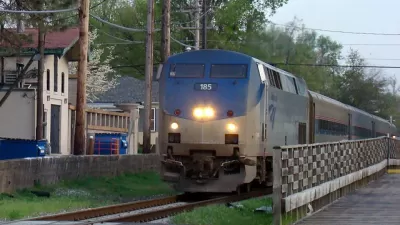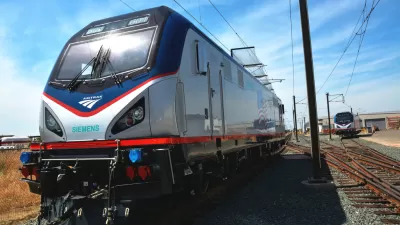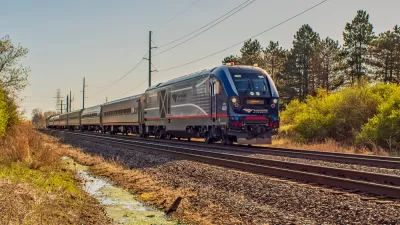Amtrak has final federal approval for train speeds of 110 miles per hour between Joliet and Alton, culminating almost ten years of planning and investing.

Amtrak and the Illinois Department of Transportation (IDOT) have received federal approval for maximum speeds up to 110 mph for most of the Chicago-St. Louis corridor, primarily between the Amtrak stations in Joliet and Alton, according to an Amtrak press release published on May 3. The new top speeds of trains on Lincoln Service and Texas Eagle trains would finally achieve a goal first identified on Planetizen in 2014.
“Until now, 90 mph has been the maximum authorized speed on the tracks owned by Union Pacific Railroad. Amtrak operates Lincoln Service and other trains under a contract with IDOT,” according to the press release.
Additional news coverage of the new top speeds on the route is available in an article by Joey Schneider for Fox 2 Now.
“Amtrak is hopeful the change will reduce times for its Lincoln Service round-trips, which also stop in Quincy and Carbondale, and the Texas Eagle, which runs from Chicago to Dallas with a St. Louis stop,” explains Schneider.
More reading from frequently delayed development of high-speed rail on the Chicago-St. Louis Corridor can be found in the Planetizen archive:
- $102 Million Brings Chicago-St. Louis High Speed Rail a Step Closer (September 2014)
- Faster Chicago to St. Louis Trains Likely to Increase Car Traffic (July 2016)
- Chicago to St. Louis Amtrak Still Not Up to Speed (January 2019)
- Higher Speeds from St. Louis to Chicago Delayed Again for Amtrak (September 2019)
- Amtrak Hits New Top Speeds Between St. Louis and Chicago (December 2021)
FULL STORY: 110 mph Schedules Coming for Amtrak Chicago-St. Louis Corridor

Planetizen Federal Action Tracker
A weekly monitor of how Trump’s orders and actions are impacting planners and planning in America.

Congressman Proposes Bill to Rename DC Metro “Trump Train”
The Make Autorail Great Again Act would withhold federal funding to the system until the Washington Metropolitan Area Transit Authority (WMATA), rebrands as the Washington Metropolitan Authority for Greater Access (WMAGA).

The Simple Legislative Tool Transforming Vacant Downtowns
In California, Michigan and Georgia, an easy win is bringing dollars — and delight — back to city centers.

Albuquerque’s Microtransit: A Planner’s Answer to Food Access Gaps
New microtransit vans in Albuquerque aim to close food access gaps by linking low-income areas to grocery stores, cutting travel times by 30 percent and offering planners a scalable model for equity-focused transit.

This City Will Pay You to Meet Your Neighbors
A North Kansas City grant program offers up to $400 for residents to throw neighborhood block parties.

Commentary: Our Silence Will Not Protect Us
Keeping our heads down and our language inoffensive is not the right response to the times we’re in. Solidarity and courage is.
Urban Design for Planners 1: Software Tools
This six-course series explores essential urban design concepts using open source software and equips planners with the tools they need to participate fully in the urban design process.
Planning for Universal Design
Learn the tools for implementing Universal Design in planning regulations.
Smith Gee Studio
City of Charlotte
City of Camden Redevelopment Agency
City of Astoria
Transportation Research & Education Center (TREC) at Portland State University
US High Speed Rail Association
City of Camden Redevelopment Agency
Municipality of Princeton (NJ)





























